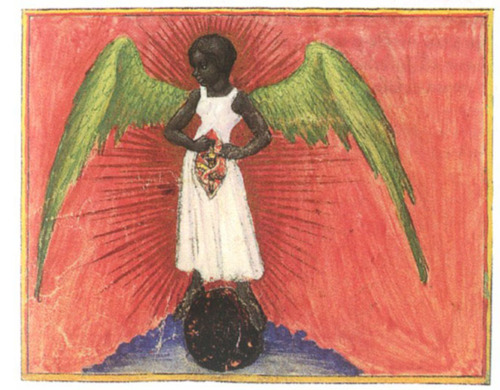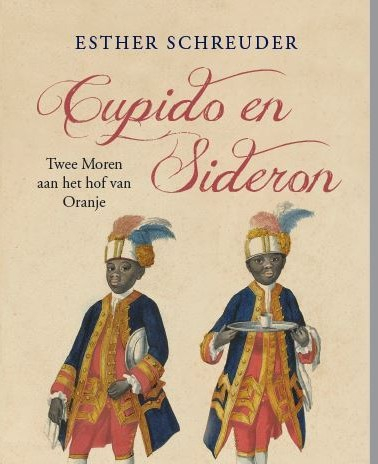
Anonymous Black angel1490 –1500 Vellum, 123 The Hague, Koninklijke Bibliotheek / Royal Library
Alongside the miniature of the Virgin and Child on this page from a book of hours, from circa 1490 –1500, there is an extremely dark-skinned angel with blonde hair playing a lute in the margin decoration. It is not the only dark figure in this manuscript, for there is a further dark-skinned angel, also with blond hair, in the margin by another miniature, although the pigment used to paint the face of the latter has probably darkened over time, for the colour is unevenly distributed.
Various experts, including Kathryn Rudy, believe that the angel on this page, however, was deliberately painted a different colour. The figure was not originally silver, as is often the case, for silver would have oxidised through the page and that is has not happened here. The illuminator probably used a pigment with a metallic sheen to give the figure an otherwordly appearance.
What could have been the reason?
Although angels appear frequently in medieval, Renaissance and baroque art, very few of them are black.

Scholars generally associate these black specimens with fallen angels, or devils.
However, this particular angel cannot be a fallen one for he is seated level with the Virgin and her Holy Child and playing music, a typical activity for angels in art, while the lute he holds is also a characteristic instrument of angels.
The instrument itself, also conspicuously dark and possibly painted with a metallic sheen too, is introduced to the Europeans by the Arabs and remained very popular throughout the centuries in Europe. Not only for sacred use, but also just for fun.

It is conceivable that above Black angel could refer to the blessed Black Madonna, whose figure drew many pilgrims and European sovereigns to the Flemish city of Halle, near Brussels, from the fourteenth century onwards. A church was erected around this figure, with Duke Philip the Good of Burgundy, Isabella of Portugal, Charles the Bold of Burgundy, Emperor Charles V and Margaret of Parma as its patrons.

Medieval Black Madonnas have no connection with Africa.
There are various ‘theories’ concerning their dark colour, the most popular of which claims that Black Madonnas were not made by human hands but were found, the dark colour being caused by the earth in which they had lain. Another theory proposes that the Virgin Mary was associated by some Doctors of the Church, such as Bernard of Clairvaux 1090 –1153, with the dark bride mentioned in the Old Testament Song of Songs. A further suggestion is that she was blackened by smoke from pilgrims’ candles.
However, the angel in this book of hours could also simply be a fanciful decorative figure, for in a similar French manuscript (ms. 3688 fol. 14), in the State Historical Museum in Moscow, there is also a dark, angelic figure, minus wings but with blond hair and the lower body of a pig, playing a harp in the margin alongside an Annunciation.
Whatever the case here, this angel is definitely a supernatural being and, like the Black Madonna, has little or no connection with Africans.
Esther Schreuder in the Black is beautiful, Rubens to Dumas catalogue (2008)
About me
In 2008 I was guest curator of the exhibition Black is beautiful. Rubens to Dumas. Important advisors: Elizabeth McGrath (Rubens and colleagues, Warburg institute Image of the Black in Western Art collection), Carl Haarnack (slavery in books), Elmer Kolfin (slavery in prints and paintings) en Adi Martis (contemporary art). Gary Schwartz made his research for The Image of the Black in Western Art available to me.

In 2014 my essay ‘Painted Blacks and Radical Imagery in the Netherlands (1900-1940)’ was published in The Image of the Black in Western Art Volume V (I). (ed. David Bindman, Henry Louis Gates jr.)

In 2017 I published a book about the black servants at the Court of the Royal Van Oranje family. More than a thousand documents have been found about their lives. (only in Dutch)

All photos on this site are not intended for any commercial purpose. I have tried to trace all the rules and rights of all images. As far as I know, these images can be used in this way. If you ar a copyright holder and would like a piece of your work removed or the creditline changed then please do not hesitate to contact me.
estherschreuderwebsite@gmail.com
